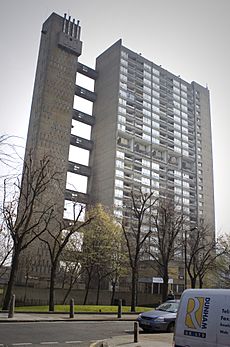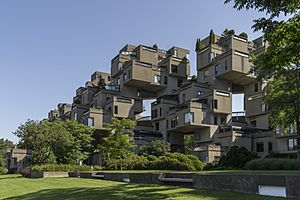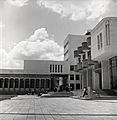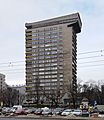Brutalist architecture facts for kids
|
Top left: Park Hill Flats in Sheffield, UK; top centre: Soviet era housing blocks in Talnakh, Russia; top right: Teresa Carreño Cultural Complex in Caracas, Venezuela; middle left: Royal National Theatre in London, UK; middle centre: Boston City Hall in Boston, US; middle right: Khrushchyovka style apartment block in the former Soviet Union; bottom left: Robarts Library in Toronto; bottom middle: Barbican Centre in London, UK; bottom right: Alexandra Road Estate in Camden, UK
|
|
| Years active | 1950s – early 1980s |
|---|---|
| Country | International |
Brutalist architecture is an architectural style which emerged during the 1950s in the United Kingdom, among the reconstruction projects of the post-war era. Brutalist buildings are characterised by minimalist constructions that showcase the bare building materials and structural elements over decorative design. The style commonly makes use of exposed, unpainted concrete or brick, angular geometric shapes and a predominantly monochrome colour palette; other materials, such as steel, timber, and glass, are also featured.
Descending from the modernist movement, Brutalism is said to be a reaction against the nostalgia of architecture in the 1940s. Derived from the Swedish phrase nybrutalism, the term "New Brutalism" was first used by British architects Alison and Peter Smithson for their pioneering approach to design. The style was further popularised in a 1955 essay by architectural critic Reyner Banham, who also associated the movement with the French phrases béton brut ("raw concrete") and art brut ("raw art"). The style, as developed by architects such as the Smithsons, Hungarian-born Ernő Goldfinger, and the British firm Chamberlin, Powell & Bon, was partly foreshadowed by the modernist work of other architects such as French-Swiss Le Corbusier, Estonian-American Louis Kahn, German-American Mies van der Rohe, and Finnish Alvar Aalto.
In the United Kingdom, Brutalism was featured in the design of utilitarian, low-cost social housing influenced by socialist principles and soon spread to other regions around the world. Brutalist designs became most commonly used in the design of institutional buildings, such as universities, libraries, courts and city halls. The popularity of the movement began to decline in the late 1970s, with some associating the style with urban decay and totalitarianism.
Brutalism has been polarising historically; specific buildings, as well as the movement as a whole, have drawn a range of criticism (often being described as "cold" or "soulless"), but have also elicited support from architects and local communities (with many brutalist buildings having become cultural icons, sometimes obtaining listed status). In recent decades, the movement has become a subject of renewed interest. In 2006, several Bostonian architects called for a rebranding of the style to "Heroic architecture" to distance itself from the negative connotations of the term "brutalism".
History

The term Nybrutalism (New Brutalism) was coined by the Swedish architect Hans Asplund to describe Villa Göth, a modern brick home in Uppsala, designed in January 1950 by his contemporaries Bengt Edman and Lennart Holm. Showcasing the 'as found' design approach that would later be at the core of Brutalism the house displays visible I-beams over windows, exposed brick inside and out, and poured concrete in several rooms where the tongue-and-groove pattern of the boards used to build the forms can be seen. The term was picked up in the summer of 1950 by a group of visiting English architects, including Michael Ventris, Oliver Cox, and Graeme Shankland, where it apparently "spread like wildfire, and [was] subsequently adopted by a certain faction of young British architects".
The first published usage of the phrase "New Brutalism" occurred in 1953, when Alison Smithson used it to describe a plan for their unbuilt Soho house which appeared in the November issue of Architectural Design. She further stated "It is our intention in this building to have the structure exposed entirely, without interior finishes wherever practicable." The Smithsons' Hunstanton School completed in 1954 in Norfolk, and the Sugden House completed in 1955 in Watford, represent the earliest examples of New Brutalism in the United Kingdom. Hunstanton school, likely inspired by Mies van der Rohe's 1946 Alumni Memorial Hall at the Illinois Institute of Technology in Chicago, United States, is notable as the first completed building in the world to carry the title of "New Brutalist" by its architects. At the time, it was described as "the most truly modern building in England".
The term gained increasingly wider recognition when British architectural historian Reyner Banham used it to identify both an ethic and aesthetic style, in his 1955 essay The New Brutalism. In the essay, Banham described Hunstanton and the Soho house as the "reference by which The New Brutalism in architecture may be defined." Reyner Banham also associated the term New Brutalism with Art Brut and béton brut, meaning raw concrete in French, for the first time. The best-known béton brut architecture is the proto-Brutalist work of the Swiss-French architect Le Corbusier, in particular his 1952 Unité d'habitation in Marseille, France; the 1953 Secretariat Building (Palace of Assembly) in Chandigarh, India; and the 1955 church of Notre Dame du Haut in Ronchamp, France.
Banham further expanded his thoughts in the 1966 book, The New Brutalism: Ethic or Aesthetic?, to characterise a somewhat recently established cluster of architectural approaches, particularly in Europe. In the book, Banham says that Le Corbusier's concrete work was a source of inspiration and helped popularise the movement, suggesting "if there is one single verbal formula that has made the concept of Brutalism admissible in most of the world's Western languages, it is that Le Corbusier himself described that concrete work as 'béton-brut'". He further states that "the words 'The New Brutalism' were already circulating, and had acquired some depth of meaning through things said and done, over and above the widely recognised connection with béton brut. The phrase still 'belonged' to the Smithsons, however, and it was their activities above all others that were giving distinctive qualities to the concept of Brutalism."
Characteristics
New Brutalism is not only an architectural style; it is also a philosophical approach to architectural design, a striving to create simple, honest, and functional buildings that accommodate their purpose, inhabitants, and location. Stylistically, Brutalism is a strict, modernistic design language that has been said to be a reaction to the architecture of the 1940s, much of which was characterised by a retrospective nostalgia. Peter Smithson believed that the core of Brutalism was a reverence for materials, expressed honestly, stating "Brutalism is not concerned with the material as such but rather the quality of material", and "the seeing of materials for what they were: the woodness of the wood; the sandiness of sand." Architect John Voelcker explained that the "New Brutalism" in architecture "cannot be understood through stylistic analysis, although some day a comprehensible style might emerge", supporting the Smithsons' description of the movement as "an ethic, not an aesthetic". Reyner Banham felt the phrase "the New Brutalism" existed as both an attitude toward design as well as a descriptive label for the architecture itself and that it "eludes precise description, while remaining a living force". He attempted to codify the movement in systematic language, insisting that a Brutalist structure must satisfy the following terms, "1, Formal legibility of plan; 2, clear exhibition of structure, and 3, valuation of materials for their inherent qualities 'as found'." Also important was the aesthetic "image", or "coherence of the building as a visual entity".
Brutalist buildings are usually constructed with reoccurring modular elements representing specific functional zones, distinctly articulated and grouped together into a unified whole. There is often an emphasis on graphic expressions in the external elevations and in the whole-site architectural plan in regard to the main functions and people-flows of the buildings. Buildings may use materials such as concrete, brick, glass, steel, timber, rough-hewn stone, and gabions among others. However, due to its low cost, raw concrete is often used and left to reveal the basic nature of its construction with rough surfaces featuring wood 'shuttering' produced when the forms were cast in-situ. Examples are frequently massive in character (even when not large) and challenge traditional notions of what a building should look like with focus given to interior spaces as much as exterior.
A common theme in Brutalist designs is the exposure of the building's inner-workings—ranging from their structure and services to their human use—in the exterior of the building. In the Boston City Hall, designed in 1962, the strikingly different and projected portions of the building indicate the special nature of the rooms behind those walls, such as the mayor's office or the city council chambers. From another perspective, the design of the Hunstanton School included placing the facility's water tank, normally a hidden service feature, in a prominent, visible tower. Rather than being hidden in the walls, Hunstanton's water and electric utilities were delivered via readily visible pipes and conduits.
Brutalism as an architectural philosophy was often associated with a socialist utopian ideology, which tended to be supported by its designers, especially by Alison and Peter Smithson, near the height of the style. Indeed, their work sought to emphasize functionality and to connect architecture with what they viewed as the realities of modern life. Among their early contributions were "streets in the sky" in which traffic and pedestrian circulation were rigorously separated, another theme popular in the 1960s. This style had a strong position in the architecture of European communist countries from the mid-1960s to the late 1980s (Bulgaria, Czechoslovakia, East Germany, USSR, Yugoslavia). In Czechoslovakia, Brutalism was presented as an attempt to create a "national" but also "modern socialist" architectural style. Such prefabricated socialist era buildings are called panelaky.
Designers
Architects whose work reflects certain aspects of the Brutalist style include Louis Kahn. Architectural historian William Jordy says that although Kahn was "[o]pposed to what he regarded as the muscular posturing of most Brutalism", some of his work "was surely informed by some of the same ideas that came to momentary focus in the Brutalist position."
In Australia, examples of the Brutalist style are Robin Gibson's Queensland Art Gallery, Ken Woolley's Fisher Library at the University of Sydney (his State Office Block is another), the High Court of Australia by Colin Madigan in Canberra, the MUSE building (also referred to as C7A MUSE) which was the original Library at Macquarie University before the new library replaced it, and WTC Wharf (World Trade Centre in Melbourne). John Andrews's government and institutional structures in Australia also exhibit the style.
Canada possesses numerous examples of Brutalist architecture. In the years leading to the 100th anniversary of the Confederation in 1967, the Federal Government financed the construction of many public buildings. Major Brutalist examples, not all built as part of the Canadian Centennial, include the Grand Théâtre de Québec, the Édifice Marie-Guyart (formerly Complex-G), Hôtel Le Concorde, and much of the Laval University campus in Quebec City; Habitat 67, Place Bonaventure, the Maison de Radio-Canada, and several metro stations on the Montreal Metro's Green Line; the Confederation Centre of the Arts in Charlottetown; the National Arts Centre in Ottawa; the Hotel Dieu Hospital in Kingston; the Ontario Science Centre, Robarts Library, Rochdale College in Toronto; and the church of the Westminster Abbey in British Columbia.
In the United Kingdom, architects associated with the Brutalist style include Ernő Goldfinger, wife-and-husband pairing Alison and Peter Smithson, some of the work of Sir Basil Spence, the London County Council/Greater London Council Architects Department, Owen Luder, John Bancroft, and, arguably perhaps, Sir Denys Lasdun, Sir Leslie Martin, Sir James Stirling and James Gowan with their early works. Some well-known examples of Brutalist-influenced architecture in the British capital include the Barbican Centre (Chamberlin, Powell and Bon) and the National Theatre (Denys Lasdun).
In the United States, Paul Rudolph and Ralph Rapson were both noted Brutalists. Evans Woollen III, a pacesetter among architects in the Midwest, is credited for introducing the Brutalist and Modernist architecture styles to Indianapolis, Indiana. Walter Netsch is known for his Brutalist academic buildings. Marcel Breuer was known for his "soft" approach to the style, often using curves rather than corners. In Atlanta, Georgia, the architectural style was introduced to Buckhead's affluent Peachtree Road with the Ted Levy-designed Plaza Towers and Park Place on Peachtree condominiums. Many of the stations of the Washington Metro, particularly older stations, were constructed in the Brutalist style.
In Serbia, Božidar Janković was a representative of the so-called "Belgrade School of residence", identifiable by its functionalist relations on the basis of the flat and elaborated in detail the architecture. Known example, Western City Gate also known as the Genex Tower is a 36-storey skyscraper in Belgrade, Serbia, which was designed in 1977 by Mihajlo Mitrović. It is formed by two towers connected with a two-storey bridge and revolving restaurant at the top. It is 117 m (384 ft) tall (with restaurant 135–140 m (443–459 ft)) and is the second-tallest high-rise in Belgrade after Ušće Tower. The building was designed in the brutalist style with some elements of structuralism and constructivism. It is considered a prime representative of the brutalist architecture in Serbia and one of the best of its style built in the 1960s and the 1970s in the world. The treatment of the form and details is slightly associating the building with postmodernism and is today one of the rare surviving representatives of this style's early period in Serbia. The artistic expression of the gate marked an entire era in Serbian architecture.
On university campuses
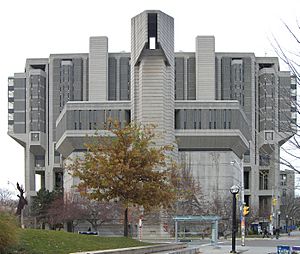
In the late 1950s and early 1960s, many North American universities constructed campus buildings in the Brutalist style due to their low cost and ease of construction, beginning with Paul Rudolph's 1958 Yale Art and Architecture Building. Rudolph's design for the University of Massachusetts Dartmouth is an example of an entire campus designed in the Brutalist style. Walter Netsch designed the entire University of Illinois-Chicago Circle Campus (now the East Campus of the University of Illinois at Chicago) under a single, unified Brutalist design. John M. Johansen and Evans Woollen III's Brutalist-style Clowes Memorial Hall, a performing arts facility that opened in 1963 on the campus of Butler University in Indianapolis, was praised for its bold and dramatic design.
In 1964, Brigham Young University inaugurated the Franklin S. Harris Fine Arts Center, which features a largely Brutalist style of architecture. The University of Chicago's Joseph Regenstein Library, one of the largest libraries in the world, is designed in the Brutalist style. The Northwestern University Library is also designed in a Brutalist style and is a good example of this type of architecture. The University of Minnesota's West Bank campus features several Brutalist buildings, including the performing arts venue, Rarig Center, one of Ralph Rapson's most important works and the best example of Brutalism in the Twin Cities. Brown University's two largest libraries and Graduate Center are significant brutalist works. The John D. Rockefeller Jr. Library and the Sciences Library (Brown University) were designed by Danforth Toan, whose firm also designed the Robarts Library at the University of Toronto.
The Boston Architectural College's main building, designed by Ashley, Myer & Associates, was completed in 1966. The design uses cantilevered, suspended masonry masses and accentuated vertical "slits" in the exterior by which some of the building's core functions can be seen from the outside. Open studio floors allow students to look in on one another's classes and studios, and the ground floor, open to Newbury Street, invites the general public into the McCormick Gallery. The building also features administration offices and two libraries.
Litchfield Towers at the University of Pittsburgh was completed in 1963 and is composed of three cylindrical Brutalist towers. The University's largest academic building, Wesley W. Posvar Hall, is a Brutalist structure completed in 1978. The University of Louisville Belknap Campus has several Brutalist buildings, including the Bingham Humanities Building and the Interfaith Center. The Andrews Building at the University of Toronto Scarborough was built in a Brutalist architectural style and completed in 1964. In 1965, Desert Modern architect E. Stewart Williams was commissioned to design a new campus for the San Bernardino Community College District. Construction of Crafton Hills College began a year later, and the last building that was part of his original campus plan was completed in 1976. Williams' Brutalist design contrasts with the steep terrain of the area and was chosen in part because it provided a firebreak from the surrounding environment. The Iowa State Center at Iowa State University originally consisted of five buildings in the Brutalist style, including a theatre, auditorium, coliseum, stadium, and events centre, as well as connecting elevated promenades. Eliot Hall, the remaining half of a pair of brutalist buildings built in 1972 on the campus of Washington University in St. Louis was demolished in 2012.
At the same period in the United Kingdom, similar expansion of higher education led to the construction of many Brutalist university buildings, notable examples being the Main Library at the University of Edinburgh, designed by Sir Basil Spence, the Boyd Orr Building at the University of Glasgow, the University of Essex, and Denys Lasdun's halls of residence at the University of East Anglia and Christ's College, Cambridge. The exterior of the University of St Andrews's Andrew Melville Hall was used as the set for Dover Recovery Centre in the film Never Let Me Go.
Brutalism today

Although the Brutalist movement was largely over by the late 1970s and early 1980s, having largely given way to Structural Expressionism and Deconstructivism, it has experienced a resurgence of interest since 2015 with the publication of a variety of guides and books, including the Brutalist London Map (2015), This Brutal World (2016), SOS Brutalism: A Global Survey (2017) as well as the lavish Atlas of Brutalist Architecture (Phaidon, 2018).
Many of the defining aspects of the style have been softened in newer buildings, with concrete façades often being sandblasted to create a stone-like surface, covered in stucco, or composed of patterned, pre-cast elements. These elements are also found in renovations of older Brutalist buildings, such as the redevelopment of Sheffield's Park Hill.
Villa Göth was listed as historically significant by the Uppsala county administrative board on 3 March 1995. Several Brutalist buildings in the United Kingdom have been granted listed status as historic and others, such as the Pirelli Building in New Haven's Long Wharf, and Gillespie, Kidd & Coia's St. Peter's Seminary, named by Prospect magazine's survey of architects as Scotland's greatest post-war building, have been the subject of conservation campaigns. The Twentieth Century Society has unsuccessfully campaigned against the demolition of British buildings such as the Tricorn Centre and Trinity Square multi-storey car park, but successfully in the case of Preston bus station garage, London's Hayward Gallery and others.
Gallery
-
Wotruba Church in Vienna (1974–76) was designed from a model by sculptor Fritz Wotruba and was a collaboration with Fritz G. Mayr, who continued the work after Wotruba's death.
-
"Pyramide" ("Pharao-Haus" or "Terrassenhochhaus") in Munich, Germany, architect Karl Helmut Bayer, 1974. Apartment building inspired by Le Corbusier's principles of modernism.
-
The Engineering Building (1959–63) at the University of Leicester, England. Designed by James Stirling, it is Grade II* listed.
-
The City of Westminster's Smithson Plaza (1959–65), formerly known as The Economist Building, served as the headquarters of The Economist until 2017. On St James's Street in Piccadilly, London, it was designed by Alison and Peter Smithson.
-
Halls of residence at the University of East Anglia (completed 1966), designed by Denys Lasdun
-
Robin Hood Gardens (1972) housing complex in Poplar, East London. Designed by the Smithsons.
-
Młotek in Warsaw (1976)
-
Perth Concert Hall, in Perth, Australia (1973)
-
Western City Gate (1979), Belgrade, Serbia
-
The interior of the Washington Metro.
See also
 In Spanish: Arquitectura brutalista para niños
In Spanish: Arquitectura brutalista para niños











